| |
|
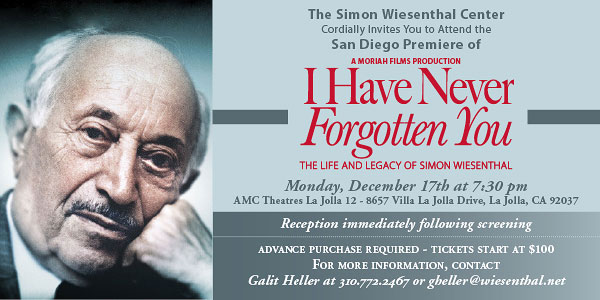

THE JEWISH CITIZEN
Some December advice for intermarried
By Donald H. Harrison
 POWAY, California—Every Jewish family in the United States knows what it feels like to be surrounded by the trappings of the Christmas season each December. We wonder if our young, impressionable children will be able to withstand the commercialism in the shopping malls and over the airwaves, and also fear that they might feel left out of the Christmas holiday celebrated by so many of their neighbors or school friends. Furthermore, some of us are concerned that if our children feel deprived of the fun their Christian friends are having, they might resent being Jewish. POWAY, California—Every Jewish family in the United States knows what it feels like to be surrounded by the trappings of the Christmas season each December. We wonder if our young, impressionable children will be able to withstand the commercialism in the shopping malls and over the airwaves, and also fear that they might feel left out of the Christmas holiday celebrated by so many of their neighbors or school friends. Furthermore, some of us are concerned that if our children feel deprived of the fun their Christian friends are having, they might resent being Jewish.
Donald H. Harrison
Problems can multiply when non-Jewish in-laws intentionally or unintentionally push Christian expectations on a Jewish family or upon an interfaith family. The non-Jewish parents may send Christmas cards, gifts wrapped in Christmas paper, toy Santas, clothing emblazoned with Christmas decorations, Christmas stockings, or even ornaments that they expect to be hung on a Christmas tree. Not wanting to hurt the feelings of the non-Jewish parents, interfaith couples and couples who have at least one partner who has recently converted to Judaism struggle with the question of how to maintain a peaceful, loving relationship with the non-Jewish relatives, yet still stick to their plans to live in a Jewish home.
Another level of complexity is addded in interfaith marriages or relationships in which one partner decides to observe Jewish holidays, and the other decides to celebrate Christian holidays. Should they have both a Christmas tree and a menorah in their home? Will having the Christmas tree make the Jewish partner feel strange, even alienated in his or her own home? Will banning a Christmas tree and other seasonal objects make the non-Jewish partner feel unwelcome in his or her own home? If both menorah and Christmas tree are displayed, should they be integrated into a single setting, or placed in different rooms? And, no matter which religion the couple has decided to raise their children in, what messages will be imparted by both symbols sharing the same house?
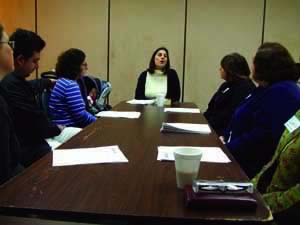 All these issues, collectively, are aspects of what has become known to Jews as the "December dilemma." Some of them were the subjects this morning for a seminar that Rabbi Tamar Malino of Temple Adat Shalom of Poway held with a half dozen adults while, nearby, the children of the Reform congregation attended Torah school. All these issues, collectively, are aspects of what has become known to Jews as the "December dilemma." Some of them were the subjects this morning for a seminar that Rabbi Tamar Malino of Temple Adat Shalom of Poway held with a half dozen adults while, nearby, the children of the Reform congregation attended Torah school.
The eight days of Chanukah have taken on more importance as the result of their proximity in the calendar to Christmas, in some years even overlapping December 25th. Jewish parents have utilized Chanukah to ward off their children's
possible Christmas envy. Transforming Chanukah into a time for giving gifts to children lessens the sense of difference, or apartness, that American Jewish children may feel from their Christian peers. While the Christians have a Christmas tree; Jews have a menorah. Wheras Christians get presents for Christmas, Jews get presents for Chanukah. The intended message of all this is that although the holidays are different, at least from the standpoint of receiving gifts and presents, they are the same.
Notwithstanding such attempts at equalization, Rabbi Malino suggested that if a direct comparison were made of the two holidays, Christmas almost invariably would be deemed the more important or significant of the two. Whereas Chanukah celebrates a battle for religious freedom (Jews resisting assimilation into a Greek culture that worshiped Zeus and other gods and goddesses), Christmas celebrates the birth of the central figure in Christianity.
During the seminar, Rabbi Malino suggested that parents not attempt to establish their children's Jewish identity on the basis of Chanukah alone, but instead to participate with them in the full range of Jewish holidays--Shabbat, Succot, Pesach, Rosh Hashanah, and others.
Jewish children may feel special that they are the only ones on their blocks to have made a blessing over the bread, or built a sukkah, or asked four questions during a seder, or blown a shofar. Observance of the full range of Jewish holidays can reinforce an understanding that Judaism is an all-involving, all-encompassing religion and lifestyle.
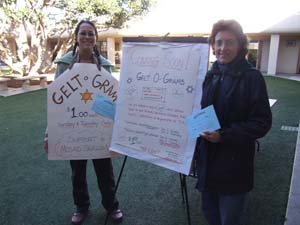 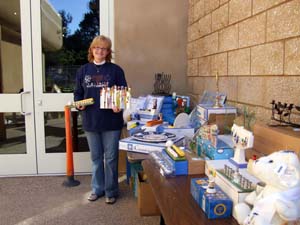
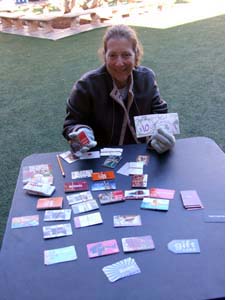 I noticed that Sunday morning activities at Temple Adat Shalom also reinforce that concept. Today for example, I saw some children rehearsing Chanukah songs, and watched others go to classes to learn about Jewish traditions. I saw temple volunteers raising money for the congregation by selling $1 gelt-o-grams, by which donors could send a Chanukah message with some foil-wrapped candy to a student, faculty or staff member at the school. Another volunteer sold gift cards for various stores or chains, earning commissions for the temple on the card sales. Additionally, in the temple's own gift shop complex, there was a range of Judaica for sale, especially hannukiot, which families left homeless by the October wildfires were invited to pick out for free. I noticed that Sunday morning activities at Temple Adat Shalom also reinforce that concept. Today for example, I saw some children rehearsing Chanukah songs, and watched others go to classes to learn about Jewish traditions. I saw temple volunteers raising money for the congregation by selling $1 gelt-o-grams, by which donors could send a Chanukah message with some foil-wrapped candy to a student, faculty or staff member at the school. Another volunteer sold gift cards for various stores or chains, earning commissions for the temple on the card sales. Additionally, in the temple's own gift shop complex, there was a range of Judaica for sale, especially hannukiot, which families left homeless by the October wildfires were invited to pick out for free.
Rabbi Malino said that as the daughter and granddaughter of rabbis, she grew up knowing her Jewish identity. Her parents were relaxed about all the Christmas symbols near their home in North Carolina; seeing the decorations, including a big waving Santa at the local shopping mall was simply an opportunity to experience an aspect of the majority culture. "We sort of enjoyed the cultural trappings of the world at large and that relaxed feeling, I think, is a good one," she said.
She recommended that interfaith families take to heart two points. It is important to respect the non-Jewish family members and it also is important that "we are very serious and clear about what our identities are and what we want the identities of our children to be," she counselled.
She urged seminar participants to "celebrate with our non-Jewish families in a way that makes for peace in families and also educates our children as much as possible." Ideally, Chanukah should be made "a rich and enjoyable and celebratory and happy experience," she said.
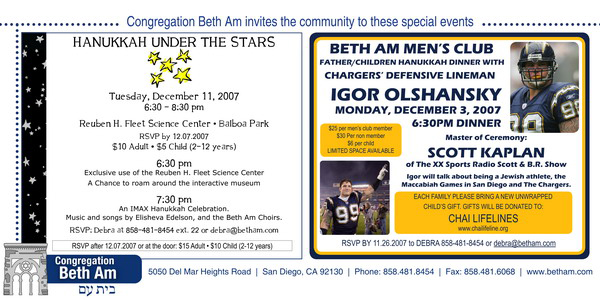

Slow down! Chanukah is not an IM
By Rabbi Matthew Earne
SAN DIEGO—The world is getting faster. In the same seven-day week our ancestors had we are expected to do more, and we do. Consequently the ways we transmit information have also gotten quicker. Regular mail is now “fittingly” called snail mail. And in the last twenty years we went from the phone to the cell phone, and we have gone from email to “fittingly” instant messaging. That’s right, if you want to tell someone something you now have the ability to say what you want to say, whenever you want to say it and no matter who the receiver is, no matter where they are, and no matter what they are doing, they will not only receive your message, but they are now responsible to respond instantly!
I must confess, over the last month I have grown to appreciate instant messaging. I fret about being forgetful so I would rather send a message before I forget what I wanted to say. I am also busy, and waiting to speak to someone or finding a meeting time is too cumbersome and there are no delays when I send an instant message.
Recently, something unexpected occurred. Upon sending an instant message, someone responded to me with an instant message. I must admit, it was exciting at first, I was sitting in my office and I did my best to respond as soon as I could. And then, I got another message, and I responded, and then another, and the back and forth continued for quite some time. Minutes turned to hours and all I focused on was responding to the message as soon as I could. I don’t know what happened around me, the next thing I knew, I was sitting at the dinner table with my wife Liz and she was asking me what I was discussing on the phone. As if I had awoken from a dream, I could not recall. You see, I was so caught up in returning information I actually forgot to really listen to the voice of the person I was messaging.
I worry about us becoming an instant messaging people. I worry that, as a consequence of needing to go so fast, we are losing the ability to fulfill the prayer of the Shema from our Siddur. How can we say “Hear O’ Israel, the Lord our God the Lord is One,” when we, the Israelites, are too busy responding to our instant messages to actually listen? It’s as if our prayer falls on deaf ears.
I also worry what happens when we rush through our sacred rituals in the same way we respond to our instant messages. What happens when we lose the ability to hear what our tradition asks of us?
This Hannukah we have a choice. We can rush home and light the candles as if responding to an instant message. It only takes a moment to fulfill our requirement to light the menorah. Or we can create an opportunity to listen to our tradition. As we light each candle we can choose to stand with the Hasmonean Priests in the dark sanctuary of the Temple. Tired and exhausted, we can stand with awe and amazement because a bottle of oil that was to only last for one day, brought light to a cold dark sanctuary for eight days.
By Sheila Orysiek
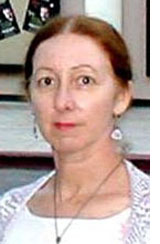 SAN DIEGO—Several events happened to me this week which at first may appear to be disassociated, but upon further reflection are connected. These events led me to think about the importance of what is sometimes called “institutional memory” or perhaps “cultural/historical memory.” This kind of memory exists both within a literary heritage as well as within an individual lifespan. SAN DIEGO—Several events happened to me this week which at first may appear to be disassociated, but upon further reflection are connected. These events led me to think about the importance of what is sometimes called “institutional memory” or perhaps “cultural/historical memory.” This kind of memory exists both within a literary heritage as well as within an individual lifespan.
For the past several years I’ve written for another online site - the oldest, largest and most prestigious dance site online; a site entirely devoted to dance. I write under the nom de plume “Anjuli Bai.” Years ago I chose to use a pseudonym because at that time I wasn’t sure I wanted my actual name online - and I liked the name of the female protagonist in the book The Far Pavilions (which at 902 pages is far too short). Because of technical considerations I can’t change it now but had I to do it again I
Sheila Orysiek
would use my real name because naming things is important.
In addition to the interactive threads and the monthly magazine, this dance site has the largest data base on dance anywhere. Though it is based in London and the contributors and readers tend to be in England, the readership and contributorship is absolutely worldwide. The participants are some of the most knowledgeable people in the dance world. However, the spectrum of expertise goes well beyond dance to include experts in music, musical composition, set design, lighting, choreography, coaching, costuming, opera, orchestration, etc., - if anyone has a question no matter how obscure - someone will come forward with the answer as well as providing a context to that answer.
For instance, if someone (me) asks a question about why a sword fight in a ballet, drama or opera, never quite looks “right” or what goes into staging one, a world renowned expert in fencing just happens along with the answer. (In a real fencing match the aim is to hit the opponent, on stage the goal is to avoid hitting an opponent and therefore timing is synchronized between the two contestants. Because the timing is synchronized - the realism is lost and intuitively the observer realizes something is not quite “right” even though the action may be properly furious.)
This dance site is regularly read by major artists, companies and voices in the arts world including the major news print media outlets (which fairly often uses quotes from the site’s participants) including the BBC (I know this because I was contacted twice by the BBC regarding my writing). The collective historical memory of both the site’s data base and the participants is overwhelming. It lends depth and meaning to the art form.
The Royal Ballet (Covent Garden, London) is currently (at the time I am writing this) dancing MacMillan’s Romeo and Juliet and a discussion in the interactive threads ensued concerning the gesture of Juliet’s nurse toward Juliet’s breasts to bring to the young teenager’s attention her maturation from child to coming womanhood. This gesture is now causing laughter from a modern audience and the question was: Has this always been the case? And if not what’s changed - is it the gesture itself or Juliet’s response? Why is the gesture now causing laughter?
The institutional memory of the older participants (moi included) were able to inform the younger balletomanes that this gesture did not cause laughter when the ballet was first performed and we were also able to give some reasons as to why. The memories of those of us who saw this ballet when it was closer to its birth (1960’s) have been able to throw light upon how it used to be and what has changed. We have a knowledge/memory base from which to draw and compare.
This week a lady I had met in Torah study died, she was a fellow congregant and a Holocaust survivor. Though I did not know Lilly Greenberg as well as I would have liked she was a sweet lady with whom I exchanged original poetry. She was the vessel of an historical memory that lived as long as she did. As she sat among us, she was a visible reminder but more than that she was a still active participant as a result of that history. When at a sisterhood meeting I raised concerns and proposed a project to help Israel communicate its message against the tidal wave of negative voices - it was Lilly who responded. She told me she well knew the power of propaganda - she was unafraid to call it what it was: propaganda.
As these survivors die, that memory threatens to die, too. That memory becomes more and more important as the primary sources - those who experienced it - leave us. We are starting to see the results as people who deny the Holocaust grow more strident - with fewer and fewer voices of the survivors left.
In an interview on CNN this week (a rebroadcast from 2006) Benjamin Netanyahu was asked whether we should take seriously the threats of violence coming from the leader and government of Iran. Netanyahu told the interviewer, Glenn Beck, that he once asked a Holocaust survivor what lesson this survivor had learned from his horrible experience. The answer is instructive: “I learned that when someone threatens to kill me, I should believe him.”
As we gradually but surely see history either being re-written or not taught at all, from seemingly small alterations such as changing a holiday from “Washington’s Birthday” to a meaningless day called “President’s Day,” we lose our sense of who we are and what can be learned from our history - we are losing the data base. It seems so simple: if someone says he is going to kill you - believe him. And, yet, we are seeing the same thing repeating itself as in the 1930’s; resounding silence as a response to resounding threats.
I had lunch with a friend whose great grandmother had been killed many years ago by lightning. As a result everyone in that family is very aware of thunderstorms and the possibility of lightning striking. They are all versed in what to avoid doing and where to avoid standing. To them it isn’t an unlikely threat at all. The family is practicing understandable survivor skills; learning from the terrible fate of a family member. This is how the human species has survived; passing down those memories and skills.
I once heard a Catholic prelate say that the Catholic Church sees things in the context of centuries. As Jews we are members of the oldest continuously culturally identifiable group in the world and we have the historical memory of several millenniums. We have millenniums of experience of hearing enemies declare their intentions and millenniums of experience of dying from - or surviving despite - those declared intentions. In the past we weren’t always able to avert the oncoming horror and now in our present circumstance as the months go by it is becoming more and more questionable whether we will be able to act in time. But first we need to stop denying the threat.
If someone loudly and clearly declares himself your enemy, declares he wants you wiped off the map of the world, has developed spears long enough to reach you and now wants to put poison on top of those spears - what’s not to believe? This time if we - America - Israel - western civilization - wait for a smoking gun, it means the gun has already been fired. In this age of mass weaponry delivered on the tip of a high speed rocket that’s too late.
What to do? There is a solution, but it’s not politically correct - it’s not even civilized - and it’s certainly not as I would like it to be - but it is survival. No matter which side of the national political divide we find ourselves, we must be willing to believe what the enemy - Iran - is saying and realize that there are times when negotiation - as with Hitler or the Crusaders or Ferdinand and Isabella or Chmelnicki, et al - doesn’t always work. It is not unusual for the enemy to use the interim of negotiations to fire up even more weapons as Hitler did. “Healing the World” - Tikkun Olam - is not a suicide pact. Even after all those nasty plagues, Pharaoh changed his mind and mounted his chariot.
A wonderful data base - whether it be of dance or history - is of no use if it isn’t used to help us assess the future. We might not like what we see in that assessment but at the end of the day, we don’t have a choice - if we want to continue to be the oldest culturally identifiable group in the world. Because we have always “been” is no guarantee we will always “be.”
|
A wonderfully cohesive program brilliantly executed ... Zina Schiff is a first rate violinist fully up to the music's tremendous technical challenges ... who can get inside the soul of Bloch's extravagantly expressive music |

HONORABLE MENSCHEN IN SPORTS
Care to compete in JCC Maccabi games?
By Joe Naiman
SAN DIEGO—The JCC Maccabi Games which will be held in San Diego in August 2008 are eight months away, but tryouts for local delegation teams begin next week.
On December 9 tryouts will begin for boys soccer, girls soccer, and girls volleyball. The soccer tryouts will begin at 10:30 a.m. at La Jolla Country Day and the volleyball tryouts will start at 11:00 a.m. at the Lawrence Family Jewish Community Center gymnasium.
The JCC Maccabi Games are a spinoff of the international Maccabiah Games, although a few differences exist. The JCC Maccabi Games are held each year in a different North American city, and San Diego was successful in bidding for the 2008 games. The JCC Maccabi Games are for youth ages 13-16, although the host organization has the option of allowing 12-year-olds into individual
sports competition and the San Diego committee has chosen to do so.
The JCC Maccabi games were first held in 1982,and the 2008 games are expected to generate between $7 million and $8 million in revenue for the San Diego area. Approximately 400 of the 1,500 estimated participants will be from the local delegation, and the participation also includes coaches, families, and volunteers.
Although under halacha (Jewish law) the children of a mixed marriage are the religion of the mother, one Jewish parent - regardless of which one - makes a child eligible for participation in the JCC Maccabi Games. Signing up is also a pre-requisite for participation, and that has already begun. Availability for the games, which will be held August 3-8, is also required.
There are no tryouts for the individual sports, although applications should be submitted as soon as possible. There are also no tryouts for the Star Reporter program which includes children who are injured and cannot participate, those who were cut during tryouts, and those who are interested in a career in writing and would like to gain experience through the daily newsletter at the games; applications are already available for that program and will be available for several months.
The team sports have three tryout sessions, although attendance at all three is not necessarily required if a child attends at least one tryout. Due to the observance of Shabbat, all team tryout sessions are on Sundays. Girls volleyball will have subsequent sessions December 16 and January 20 while boys and girls soccer will have additional tryouts December 16 and January 13.
Tryouts for boys basketball, girls basketball, boys baseball, and co-ed flag football will take place
January 6, January 13, and January 20 with basketball and baseball tryouts taking place at La Jolla Country Day and flag football tryouts being held on the JCC fields.
Verification of age and medical permission slips are not needed at the time of tryouts, although a
parental permission signature section is included in the application form which is needed at the time
of the tryouts.
Further information on tryouts can be obtained by calling Dan Wagner at (858) 362-1125.
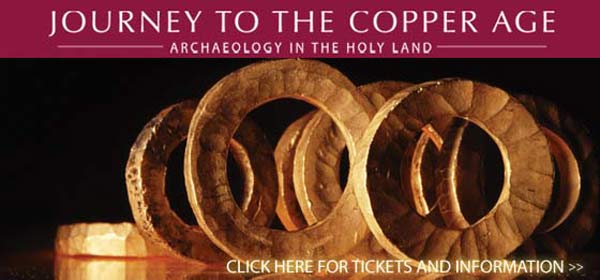

L.A. BEAT
Zypora's love affair with the Yiddish theatre
By Cynthia Citron
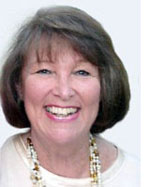 LOS ANGELES - All those who know who Zypora Spaisman was, raise your hands. Hmmm, not many hands, I see. LOS ANGELES - All those who know who Zypora Spaisman was, raise your hands. Hmmm, not many hands, I see.
Well, Zypora Spaisman was an actress/entrepreneur who devoted the last half of the 20th century to trying to keep Yiddish Theater alive in New York City. And now a beautiful documentary by Israeli director Dan Kotzir records that struggle; it’s called Yiddish Theatre: A Love Story.
As it happened, the waves of Jewish immigrants who arrived in America from Eastern Europe during the last years of the 19th century and the first
Cynthia Citron
couple of decades of the 20th brought with them a well-developed culture and a language that had been viable for more than a thousand years: Yiddish. Many didn’t venture too far from Ellis Island, settling into a new shtetl that evolved on the Lower East Side of Manhattan.
Speaking Yiddish, the language that united them, these newcomers established neighborhood theaters to perform plays based on folk tales they had brought with them from “the old country,” as well as translations and adaptations of the classic plays of the major European playwrights. At its height, Yiddish theater in New York was presented in 12 venues strung out along 2nd Avenue. (And with more than 200 theaters and traveling groups around the country).
But as the Holocaust destroyed the Jews who had remained behind in Europe, their language also began to fade. It was perceived, as someone in the film points out, as “the language of the dead.” So as an extraordinary new generation of artists, the sons and daughters of the early immigrants, grew up in America to become actors, writers, musicians, comedians, and ultimately, filmmakers, they worked in English.
Yiddish speakers became even more scarce as Hebrew became the official language of the Jews of Israel. Further, as the Jews of the Lower East Side became more prosperous and moved out of the area, other ethnicities moved in. What used to be almost entirely Jewish is now a part of Chinatown.
In 1954, however, a 38-year old human dynamo named Zypora Spaisman appeared on the scene. She had been a midwife back in Poland, but when she arrived in America she decided to become an actress. She was a natural at it and soon became a fixture of the Folksbiene, the Yiddish Theatre group that was founded in the early years of the last century. (This group is the last one still viable, and it operates as the National Yiddish Theater- Folksbiene.)
Spaisman made it her mission to keep Yiddish Theater alive, and Yiddish Theater: A Love Story documents her struggle. The film follows her in real time through the eight days of Chanukah, as each Chanukah candle illuminates the way to the end: the closing of her theater, the Mazar. This 199-seat house, which presented plays in Yiddish with English translations on a banner screen above the stage (as is common in opera performances today), had dwindled to performing for as few as eight people. Eight OLD people, since few young people speak or understand Yiddish these days.
The film records her slogging around Manhattan in 2002, during the most severe snowstorm in decades, visiting philanthropists that she hoped would support her theater. In this she was joined by a handsome, eternally cheerful friend named David Romero. (It is Romero who, after an unsuccessful phone call to a Jewish potential benefactor, reports with a rueful smile that the man had turned him down because “he says he supports the Chinese theater.”)
In addition to Romero, there are visits and interviews with stalwarts of the Yiddish stage, many of whom reveal the quintessential sense of humor unique to the Jewish people.
There is also beautiful footage of what can only be described as “Woody Allen’s Manhattan” in sunshine and in snow. It is a surprisingly well made, fascinating film. Even more amazing when you learn that it had a budget of only $100,000.
In the end, however, after all her hopes and prayers, Spaisman, who was still acting at 85, had to close her theater. She died shortly afterwards, at the age of 86.
Yiddish Theater: A Love Story has been making the rounds (and winning prizes) at various film festivals, and was premiered in Israel. It is currently playing in New York and has been brought to Los Angeles by Laemmle Theaters. The producers are hoping for backing that will allow them to open the film around the country, and for word of mouth that will persuade the Laemmles that there is an appreciative audience for this wonderful documentary.
|
|

